Macroeconomic Analysis and Unilever's Business Performance (2016-2020)
VerifiedAdded on 2023/06/16
|10
|2937
|96
Report
AI Summary
This report provides a comprehensive analysis of Unilever's management economics, focusing on strategies implemented between 2016 and 2020. It includes a five-year macroeconomic data comparison between the United Kingdom, the United States, and China, considering growth, inflation, interest rates, unemployment, and current account balance. The report evaluates Unilever's business performance in the UK, comparing it with operations in the other two countries, and highlights changes in overall performance. It also discusses the impact of the United Kingdom's trade policies, particularly Brexit, on Unilever's operations, including sourcing and input costs. The analysis covers Unilever's sustainable living brands, their growth, and contributions to social and environmental goals, along with specific initiatives like sanitation, hygiene, and sustainable sourcing.
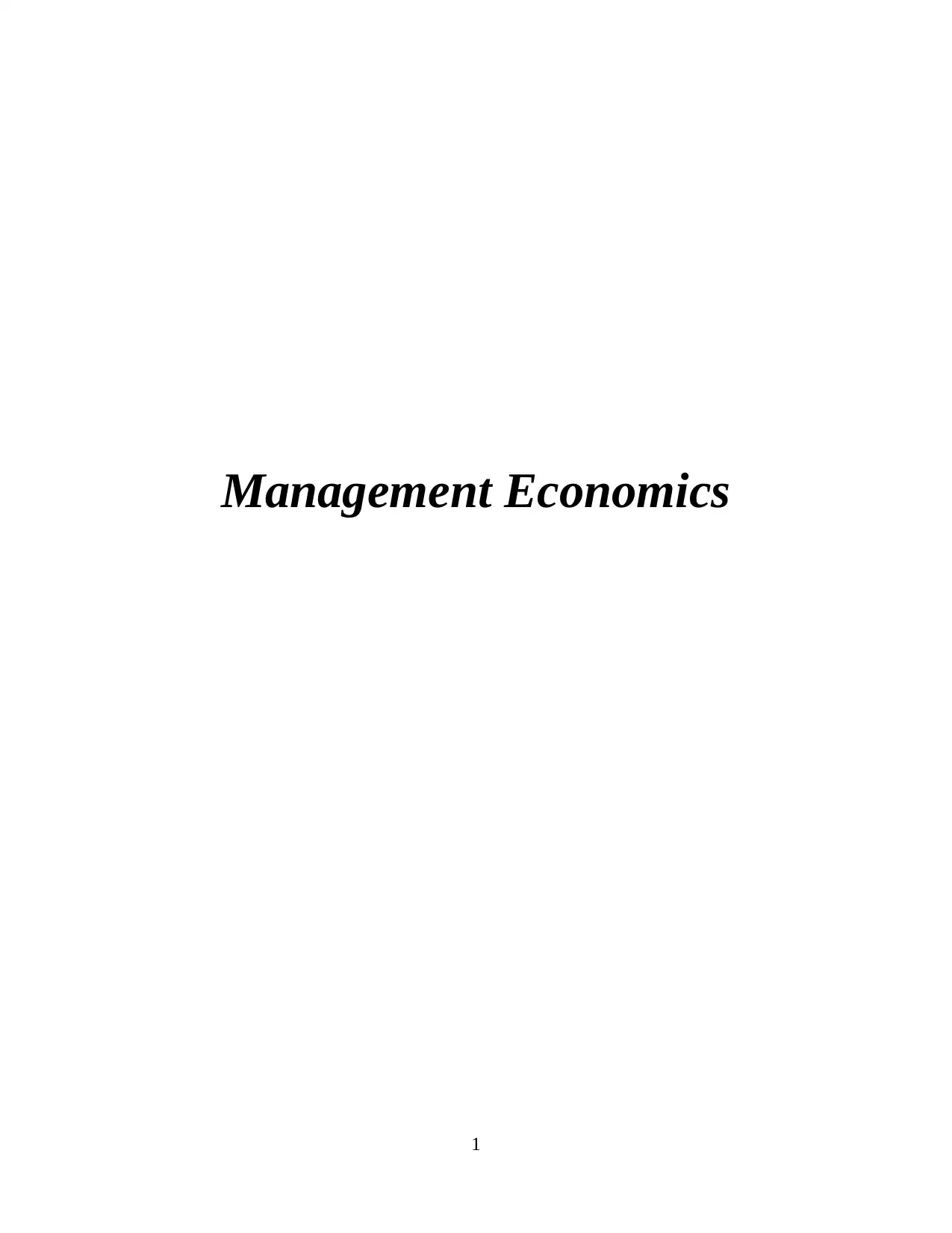
Management Economics
1
1
Paraphrase This Document
Need a fresh take? Get an instant paraphrase of this document with our AI Paraphraser

Table of content
Table of Contents
Introduction......................................................................................................................................3
Tasks................................................................................................................................................3
An overview of the strategies of the organisation that have unfolded in the duration of 2016-
2020.............................................................................................................................................3
A five year macro economic data comparison between the three countries where the
organisation operates. The points of difference that can be considered are growth, inflation,
interest rates, unemployment as well as current account balance. .............................................5
Evaluation of the business performance of the organisation in the last years in terms of
operations within UK and a comparison of operations with two other countries as well. .........6
Highlight the various changes that have been observed in the overall performance of the
organisation in the three countries. Discuss the extent to which the trade policies of the United
Kingdom have an impact upon the overall performance of the organisation. ...........................7
Conclusion.......................................................................................................................................9
References......................................................................................................................................10
2
Table of Contents
Introduction......................................................................................................................................3
Tasks................................................................................................................................................3
An overview of the strategies of the organisation that have unfolded in the duration of 2016-
2020.............................................................................................................................................3
A five year macro economic data comparison between the three countries where the
organisation operates. The points of difference that can be considered are growth, inflation,
interest rates, unemployment as well as current account balance. .............................................5
Evaluation of the business performance of the organisation in the last years in terms of
operations within UK and a comparison of operations with two other countries as well. .........6
Highlight the various changes that have been observed in the overall performance of the
organisation in the three countries. Discuss the extent to which the trade policies of the United
Kingdom have an impact upon the overall performance of the organisation. ...........................7
Conclusion.......................................................................................................................................9
References......................................................................................................................................10
2
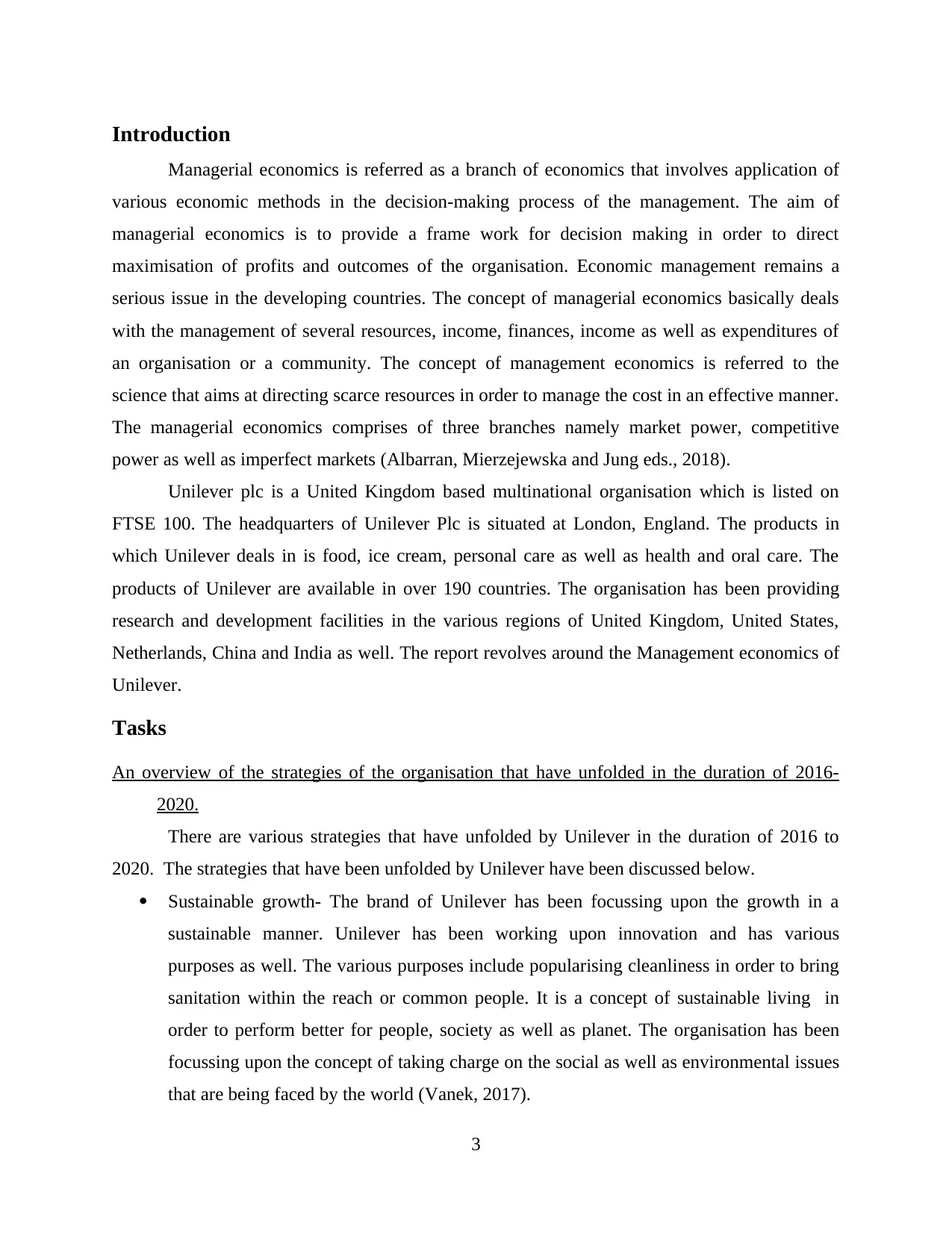
Introduction
Managerial economics is referred as a branch of economics that involves application of
various economic methods in the decision-making process of the management. The aim of
managerial economics is to provide a frame work for decision making in order to direct
maximisation of profits and outcomes of the organisation. Economic management remains a
serious issue in the developing countries. The concept of managerial economics basically deals
with the management of several resources, income, finances, income as well as expenditures of
an organisation or a community. The concept of management economics is referred to the
science that aims at directing scarce resources in order to manage the cost in an effective manner.
The managerial economics comprises of three branches namely market power, competitive
power as well as imperfect markets (Albarran, Mierzejewska and Jung eds., 2018).
Unilever plc is a United Kingdom based multinational organisation which is listed on
FTSE 100. The headquarters of Unilever Plc is situated at London, England. The products in
which Unilever deals in is food, ice cream, personal care as well as health and oral care. The
products of Unilever are available in over 190 countries. The organisation has been providing
research and development facilities in the various regions of United Kingdom, United States,
Netherlands, China and India as well. The report revolves around the Management economics of
Unilever.
Tasks
An overview of the strategies of the organisation that have unfolded in the duration of 2016-
2020.
There are various strategies that have unfolded by Unilever in the duration of 2016 to
2020. The strategies that have been unfolded by Unilever have been discussed below.
Sustainable growth- The brand of Unilever has been focussing upon the growth in a
sustainable manner. Unilever has been working upon innovation and has various
purposes as well. The various purposes include popularising cleanliness in order to bring
sanitation within the reach or common people. It is a concept of sustainable living in
order to perform better for people, society as well as planet. The organisation has been
focussing upon the concept of taking charge on the social as well as environmental issues
that are being faced by the world (Vanek, 2017).
3
Managerial economics is referred as a branch of economics that involves application of
various economic methods in the decision-making process of the management. The aim of
managerial economics is to provide a frame work for decision making in order to direct
maximisation of profits and outcomes of the organisation. Economic management remains a
serious issue in the developing countries. The concept of managerial economics basically deals
with the management of several resources, income, finances, income as well as expenditures of
an organisation or a community. The concept of management economics is referred to the
science that aims at directing scarce resources in order to manage the cost in an effective manner.
The managerial economics comprises of three branches namely market power, competitive
power as well as imperfect markets (Albarran, Mierzejewska and Jung eds., 2018).
Unilever plc is a United Kingdom based multinational organisation which is listed on
FTSE 100. The headquarters of Unilever Plc is situated at London, England. The products in
which Unilever deals in is food, ice cream, personal care as well as health and oral care. The
products of Unilever are available in over 190 countries. The organisation has been providing
research and development facilities in the various regions of United Kingdom, United States,
Netherlands, China and India as well. The report revolves around the Management economics of
Unilever.
Tasks
An overview of the strategies of the organisation that have unfolded in the duration of 2016-
2020.
There are various strategies that have unfolded by Unilever in the duration of 2016 to
2020. The strategies that have been unfolded by Unilever have been discussed below.
Sustainable growth- The brand of Unilever has been focussing upon the growth in a
sustainable manner. Unilever has been working upon innovation and has various
purposes as well. The various purposes include popularising cleanliness in order to bring
sanitation within the reach or common people. It is a concept of sustainable living in
order to perform better for people, society as well as planet. The organisation has been
focussing upon the concept of taking charge on the social as well as environmental issues
that are being faced by the world (Vanek, 2017).
3
⊘ This is a preview!⊘
Do you want full access?
Subscribe today to unlock all pages.

Trusted by 1+ million students worldwide
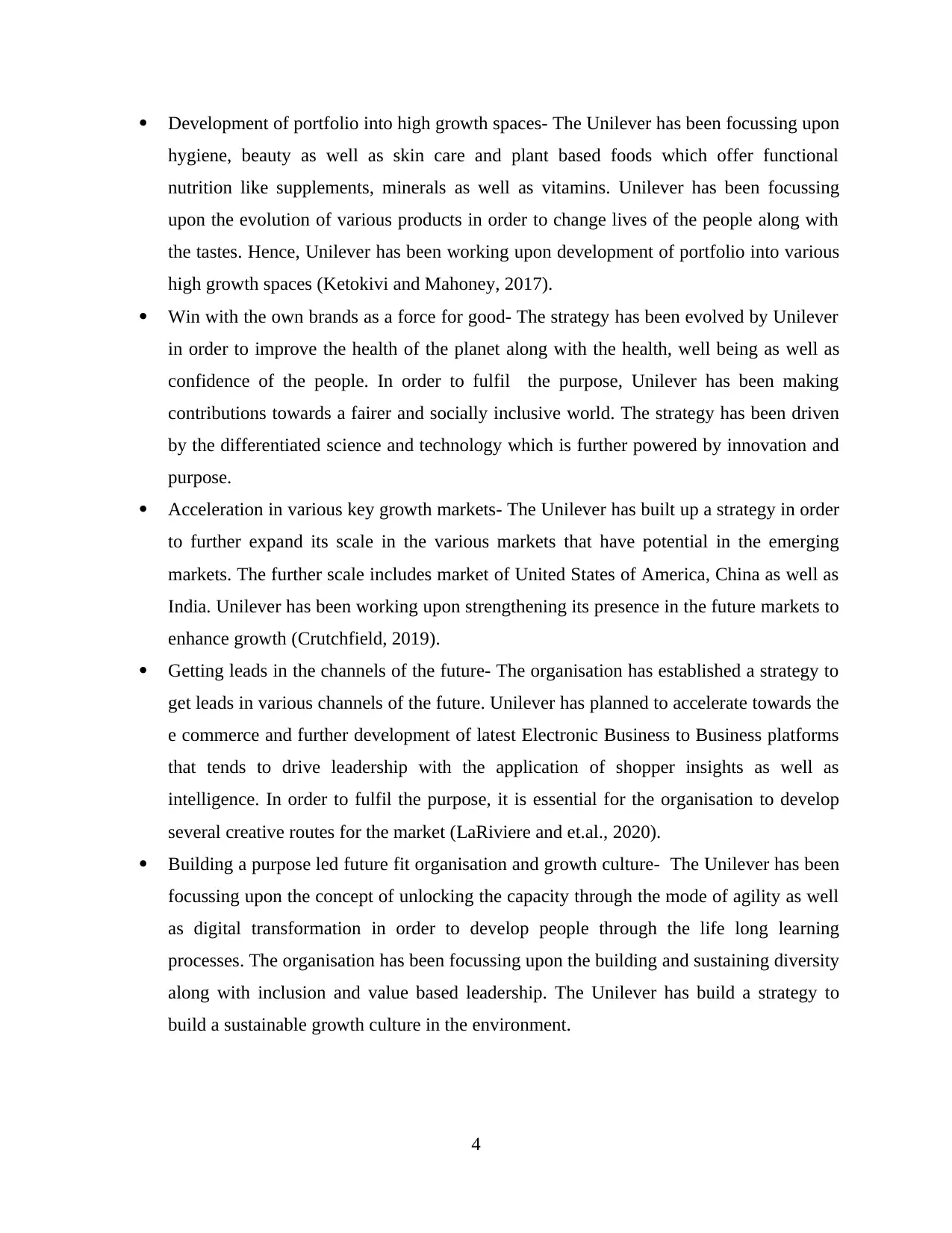
Development of portfolio into high growth spaces- The Unilever has been focussing upon
hygiene, beauty as well as skin care and plant based foods which offer functional
nutrition like supplements, minerals as well as vitamins. Unilever has been focussing
upon the evolution of various products in order to change lives of the people along with
the tastes. Hence, Unilever has been working upon development of portfolio into various
high growth spaces (Ketokivi and Mahoney, 2017).
Win with the own brands as a force for good- The strategy has been evolved by Unilever
in order to improve the health of the planet along with the health, well being as well as
confidence of the people. In order to fulfil the purpose, Unilever has been making
contributions towards a fairer and socially inclusive world. The strategy has been driven
by the differentiated science and technology which is further powered by innovation and
purpose.
Acceleration in various key growth markets- The Unilever has built up a strategy in order
to further expand its scale in the various markets that have potential in the emerging
markets. The further scale includes market of United States of America, China as well as
India. Unilever has been working upon strengthening its presence in the future markets to
enhance growth (Crutchfield, 2019).
Getting leads in the channels of the future- The organisation has established a strategy to
get leads in various channels of the future. Unilever has planned to accelerate towards the
e commerce and further development of latest Electronic Business to Business platforms
that tends to drive leadership with the application of shopper insights as well as
intelligence. In order to fulfil the purpose, it is essential for the organisation to develop
several creative routes for the market (LaRiviere and et.al., 2020).
Building a purpose led future fit organisation and growth culture- The Unilever has been
focussing upon the concept of unlocking the capacity through the mode of agility as well
as digital transformation in order to develop people through the life long learning
processes. The organisation has been focussing upon the building and sustaining diversity
along with inclusion and value based leadership. The Unilever has build a strategy to
build a sustainable growth culture in the environment.
4
hygiene, beauty as well as skin care and plant based foods which offer functional
nutrition like supplements, minerals as well as vitamins. Unilever has been focussing
upon the evolution of various products in order to change lives of the people along with
the tastes. Hence, Unilever has been working upon development of portfolio into various
high growth spaces (Ketokivi and Mahoney, 2017).
Win with the own brands as a force for good- The strategy has been evolved by Unilever
in order to improve the health of the planet along with the health, well being as well as
confidence of the people. In order to fulfil the purpose, Unilever has been making
contributions towards a fairer and socially inclusive world. The strategy has been driven
by the differentiated science and technology which is further powered by innovation and
purpose.
Acceleration in various key growth markets- The Unilever has built up a strategy in order
to further expand its scale in the various markets that have potential in the emerging
markets. The further scale includes market of United States of America, China as well as
India. Unilever has been working upon strengthening its presence in the future markets to
enhance growth (Crutchfield, 2019).
Getting leads in the channels of the future- The organisation has established a strategy to
get leads in various channels of the future. Unilever has planned to accelerate towards the
e commerce and further development of latest Electronic Business to Business platforms
that tends to drive leadership with the application of shopper insights as well as
intelligence. In order to fulfil the purpose, it is essential for the organisation to develop
several creative routes for the market (LaRiviere and et.al., 2020).
Building a purpose led future fit organisation and growth culture- The Unilever has been
focussing upon the concept of unlocking the capacity through the mode of agility as well
as digital transformation in order to develop people through the life long learning
processes. The organisation has been focussing upon the building and sustaining diversity
along with inclusion and value based leadership. The Unilever has build a strategy to
build a sustainable growth culture in the environment.
4
Paraphrase This Document
Need a fresh take? Get an instant paraphrase of this document with our AI Paraphraser

A five year macro economic data comparison between the three countries where the organisation
operates. The points of difference that can be considered are growth, inflation, interest
rates, unemployment as well as current account balance.
The macro economic data of Unilever is being compared between the three countries
which is United States, United Kingdom and China for the years 2016 to 2020. The points of
difference that are to be considered for the report are growth, inflation, interest rates,
unemployment and current account balance. The comparison has been performed below
(Martinho, 2019).
For the year 2016
Points of Difference United Kingdom United States China
Growth - - -
Inflation 0.04% 2.10% 2.00%
Interest rates 0.25% 0.50% 4.30%
Unemployment 4.81% 4.87% 4.02%
Current Account
balance
- - -
For the year 2017
Points of Difference United Kingdom United States China
Growth 8.86% - -
Inflation 0.66% 2.10% 1.56%
Interest rates 0.50% 0.75% 4.30%
Unemployment 4.33% 4.36% 3.90%
Current Account
balance
- - -
For the year 2018
Points of Difference United Kingdom United States China
5
operates. The points of difference that can be considered are growth, inflation, interest
rates, unemployment as well as current account balance.
The macro economic data of Unilever is being compared between the three countries
which is United States, United Kingdom and China for the years 2016 to 2020. The points of
difference that are to be considered for the report are growth, inflation, interest rates,
unemployment and current account balance. The comparison has been performed below
(Martinho, 2019).
For the year 2016
Points of Difference United Kingdom United States China
Growth - - -
Inflation 0.04% 2.10% 2.00%
Interest rates 0.25% 0.50% 4.30%
Unemployment 4.81% 4.87% 4.02%
Current Account
balance
- - -
For the year 2017
Points of Difference United Kingdom United States China
Growth 8.86% - -
Inflation 0.66% 2.10% 1.56%
Interest rates 0.50% 0.75% 4.30%
Unemployment 4.33% 4.36% 3.90%
Current Account
balance
- - -
For the year 2018
Points of Difference United Kingdom United States China
5
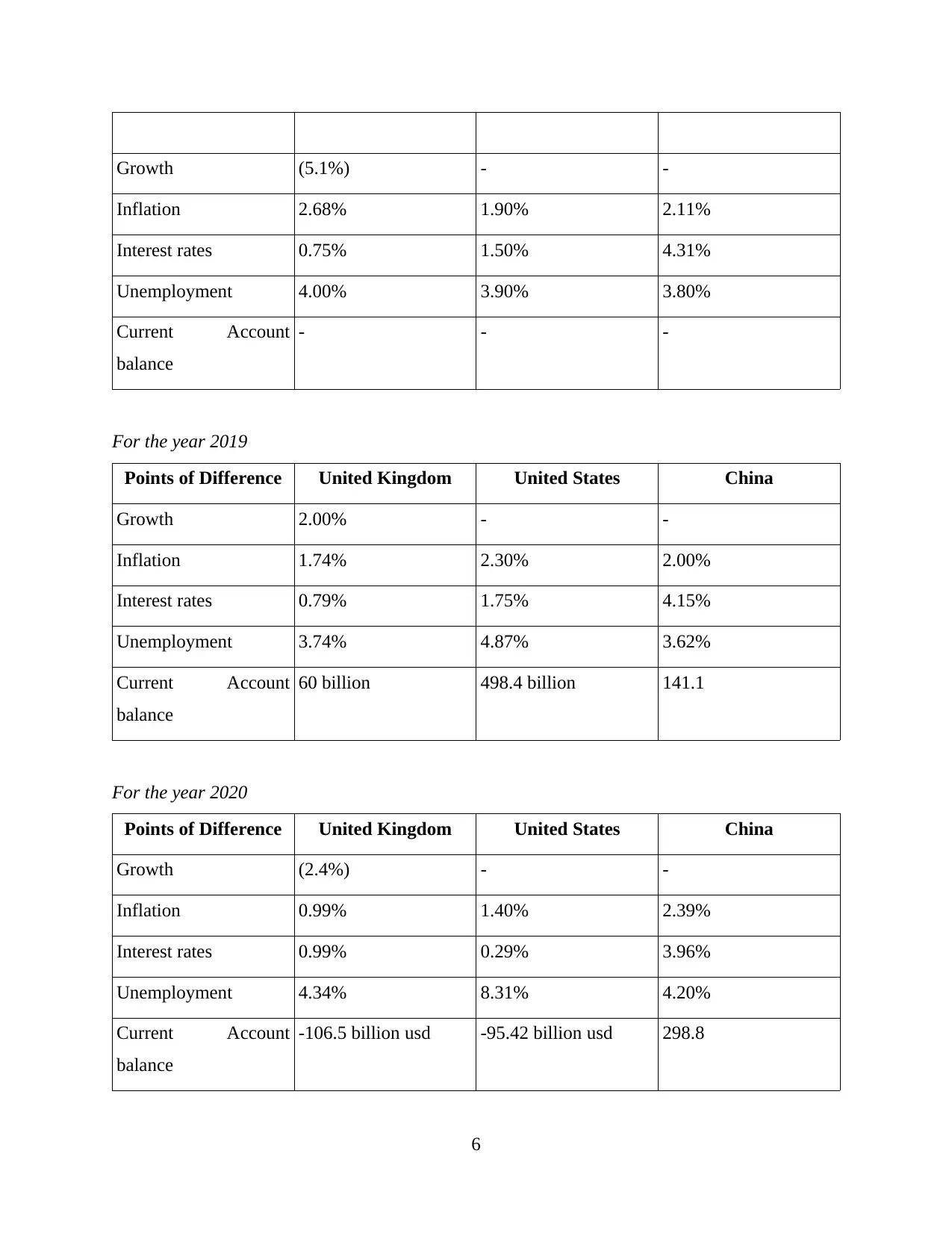
Growth (5.1%) - -
Inflation 2.68% 1.90% 2.11%
Interest rates 0.75% 1.50% 4.31%
Unemployment 4.00% 3.90% 3.80%
Current Account
balance
- - -
For the year 2019
Points of Difference United Kingdom United States China
Growth 2.00% - -
Inflation 1.74% 2.30% 2.00%
Interest rates 0.79% 1.75% 4.15%
Unemployment 3.74% 4.87% 3.62%
Current Account
balance
60 billion 498.4 billion 141.1
For the year 2020
Points of Difference United Kingdom United States China
Growth (2.4%) - -
Inflation 0.99% 1.40% 2.39%
Interest rates 0.99% 0.29% 3.96%
Unemployment 4.34% 8.31% 4.20%
Current Account
balance
-106.5 billion usd -95.42 billion usd 298.8
6
Inflation 2.68% 1.90% 2.11%
Interest rates 0.75% 1.50% 4.31%
Unemployment 4.00% 3.90% 3.80%
Current Account
balance
- - -
For the year 2019
Points of Difference United Kingdom United States China
Growth 2.00% - -
Inflation 1.74% 2.30% 2.00%
Interest rates 0.79% 1.75% 4.15%
Unemployment 3.74% 4.87% 3.62%
Current Account
balance
60 billion 498.4 billion 141.1
For the year 2020
Points of Difference United Kingdom United States China
Growth (2.4%) - -
Inflation 0.99% 1.40% 2.39%
Interest rates 0.99% 0.29% 3.96%
Unemployment 4.34% 8.31% 4.20%
Current Account
balance
-106.5 billion usd -95.42 billion usd 298.8
6
⊘ This is a preview!⊘
Do you want full access?
Subscribe today to unlock all pages.

Trusted by 1+ million students worldwide

Evaluation of the business performance of the organisation in the last years in terms of
operations within UK and a comparison of operations with two other countries as well.
The business performance of Unilever has expanded in quite positive terms in the last
five years. Unilever has experienced growth in the five consecutive years in order to perform the
sustainable living brands which have grown by 46% that has been quicker than the rest of the
businesses. Unilever has delivered approximately 70% of the total turnover growth. The brands
of Unilever have been making efforts in order to reduce its environmental footprint while
increasing the positive impact upon the social concerns (Chang, McAleer and Wong, 2018). In
order to reveal the changes that have been brought in at Unilever plc are discussed below-
At present, Unilever has 26 sustainable living brands which have increased from 18
brands since the year 2016. The new entrants that have been introduced in the business
are Vaseline, Sunsilk, Sunlight and Wall's.
The list comprises of various brands of Unilever that have been considered as the top 6
brands of Unilever are Dove, Rexona, Dirt is Good, Lipton, knorr and Hellman's along
with the B- Corp. certified brands like Seventh Generation, Ben and Jerry's along with
Pukka Herbs (da Silva, Weins and Potinkara, 2019).
In the last five years, the sustainable living brands of Unilever have been able to perform
the average rate of growth at Unilever. In the year 2017, sustainable living brands have
grown or expanded by 46% faster in comparison to the other business brands and it has
further delivered 70% of the Unilever's turnover growth.
Highlight the various changes that have been observed in the overall performance of the
organisation in the three countries. Discuss the extent to which the trade policies of the
United Kingdom have an impact upon the overall performance of the organisation.
Unilever has experienced various changes that can be observed in aspect of the overall
performance of Unilever. The various changes that have been observed in the overall
performance of Unilever in the three countries have been explained below.
By the end of the year 2017, over 600 million people have been reached out with the help
of various programmes of the Unilever in aspect of sanitation, oral health, hand washing
as well as self esteem along with providing safe and secure drinking water. The reach of
7
operations within UK and a comparison of operations with two other countries as well.
The business performance of Unilever has expanded in quite positive terms in the last
five years. Unilever has experienced growth in the five consecutive years in order to perform the
sustainable living brands which have grown by 46% that has been quicker than the rest of the
businesses. Unilever has delivered approximately 70% of the total turnover growth. The brands
of Unilever have been making efforts in order to reduce its environmental footprint while
increasing the positive impact upon the social concerns (Chang, McAleer and Wong, 2018). In
order to reveal the changes that have been brought in at Unilever plc are discussed below-
At present, Unilever has 26 sustainable living brands which have increased from 18
brands since the year 2016. The new entrants that have been introduced in the business
are Vaseline, Sunsilk, Sunlight and Wall's.
The list comprises of various brands of Unilever that have been considered as the top 6
brands of Unilever are Dove, Rexona, Dirt is Good, Lipton, knorr and Hellman's along
with the B- Corp. certified brands like Seventh Generation, Ben and Jerry's along with
Pukka Herbs (da Silva, Weins and Potinkara, 2019).
In the last five years, the sustainable living brands of Unilever have been able to perform
the average rate of growth at Unilever. In the year 2017, sustainable living brands have
grown or expanded by 46% faster in comparison to the other business brands and it has
further delivered 70% of the Unilever's turnover growth.
Highlight the various changes that have been observed in the overall performance of the
organisation in the three countries. Discuss the extent to which the trade policies of the
United Kingdom have an impact upon the overall performance of the organisation.
Unilever has experienced various changes that can be observed in aspect of the overall
performance of Unilever. The various changes that have been observed in the overall
performance of Unilever in the three countries have been explained below.
By the end of the year 2017, over 600 million people have been reached out with the help
of various programmes of the Unilever in aspect of sanitation, oral health, hand washing
as well as self esteem along with providing safe and secure drinking water. The reach of
7
Paraphrase This Document
Need a fresh take? Get an instant paraphrase of this document with our AI Paraphraser
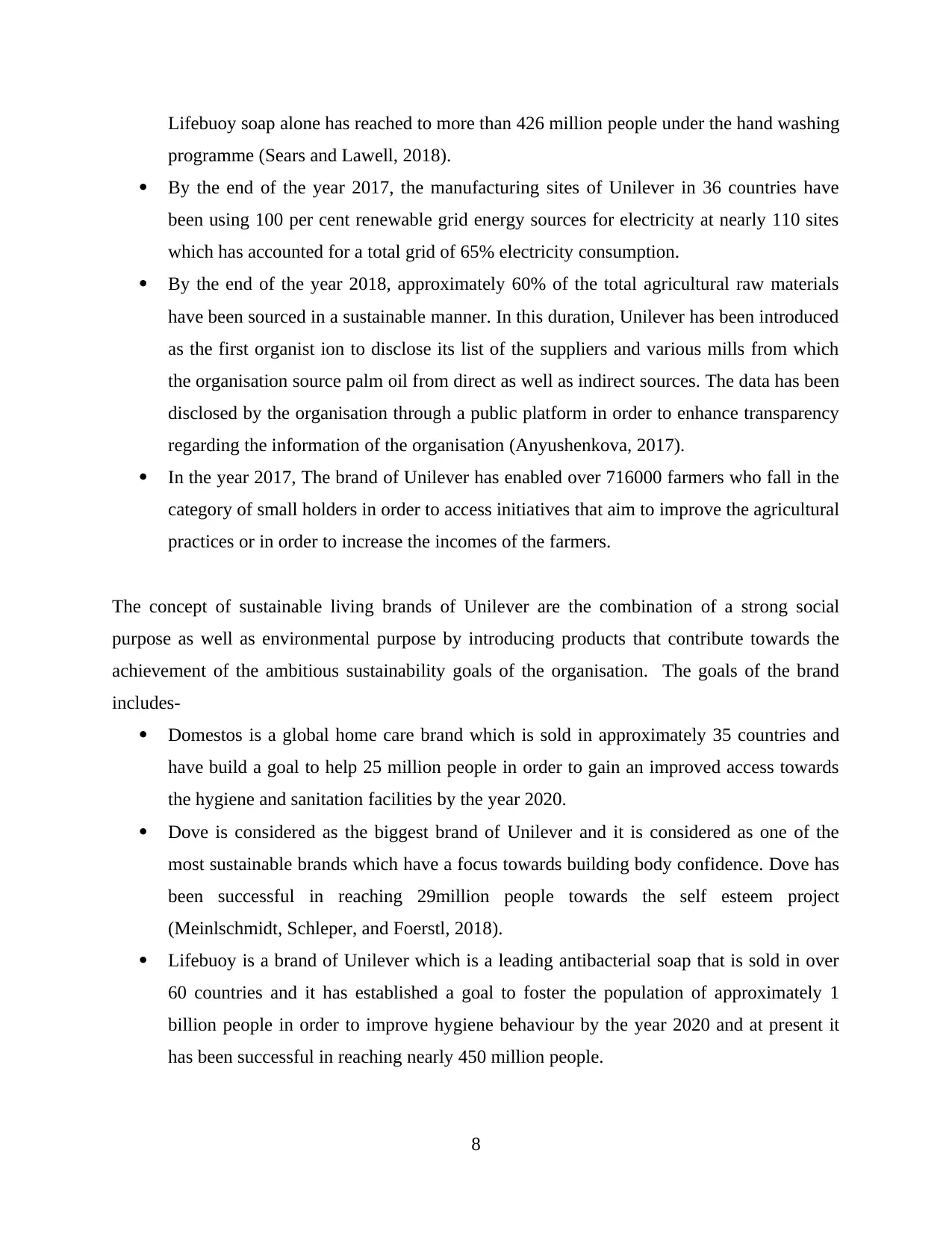
Lifebuoy soap alone has reached to more than 426 million people under the hand washing
programme (Sears and Lawell, 2018).
By the end of the year 2017, the manufacturing sites of Unilever in 36 countries have
been using 100 per cent renewable grid energy sources for electricity at nearly 110 sites
which has accounted for a total grid of 65% electricity consumption.
By the end of the year 2018, approximately 60% of the total agricultural raw materials
have been sourced in a sustainable manner. In this duration, Unilever has been introduced
as the first organist ion to disclose its list of the suppliers and various mills from which
the organisation source palm oil from direct as well as indirect sources. The data has been
disclosed by the organisation through a public platform in order to enhance transparency
regarding the information of the organisation (Anyushenkova, 2017).
In the year 2017, The brand of Unilever has enabled over 716000 farmers who fall in the
category of small holders in order to access initiatives that aim to improve the agricultural
practices or in order to increase the incomes of the farmers.
The concept of sustainable living brands of Unilever are the combination of a strong social
purpose as well as environmental purpose by introducing products that contribute towards the
achievement of the ambitious sustainability goals of the organisation. The goals of the brand
includes-
Domestos is a global home care brand which is sold in approximately 35 countries and
have build a goal to help 25 million people in order to gain an improved access towards
the hygiene and sanitation facilities by the year 2020.
Dove is considered as the biggest brand of Unilever and it is considered as one of the
most sustainable brands which have a focus towards building body confidence. Dove has
been successful in reaching 29million people towards the self esteem project
(Meinlschmidt, Schleper, and Foerstl, 2018).
Lifebuoy is a brand of Unilever which is a leading antibacterial soap that is sold in over
60 countries and it has established a goal to foster the population of approximately 1
billion people in order to improve hygiene behaviour by the year 2020 and at present it
has been successful in reaching nearly 450 million people.
8
programme (Sears and Lawell, 2018).
By the end of the year 2017, the manufacturing sites of Unilever in 36 countries have
been using 100 per cent renewable grid energy sources for electricity at nearly 110 sites
which has accounted for a total grid of 65% electricity consumption.
By the end of the year 2018, approximately 60% of the total agricultural raw materials
have been sourced in a sustainable manner. In this duration, Unilever has been introduced
as the first organist ion to disclose its list of the suppliers and various mills from which
the organisation source palm oil from direct as well as indirect sources. The data has been
disclosed by the organisation through a public platform in order to enhance transparency
regarding the information of the organisation (Anyushenkova, 2017).
In the year 2017, The brand of Unilever has enabled over 716000 farmers who fall in the
category of small holders in order to access initiatives that aim to improve the agricultural
practices or in order to increase the incomes of the farmers.
The concept of sustainable living brands of Unilever are the combination of a strong social
purpose as well as environmental purpose by introducing products that contribute towards the
achievement of the ambitious sustainability goals of the organisation. The goals of the brand
includes-
Domestos is a global home care brand which is sold in approximately 35 countries and
have build a goal to help 25 million people in order to gain an improved access towards
the hygiene and sanitation facilities by the year 2020.
Dove is considered as the biggest brand of Unilever and it is considered as one of the
most sustainable brands which have a focus towards building body confidence. Dove has
been successful in reaching 29million people towards the self esteem project
(Meinlschmidt, Schleper, and Foerstl, 2018).
Lifebuoy is a brand of Unilever which is a leading antibacterial soap that is sold in over
60 countries and it has established a goal to foster the population of approximately 1
billion people in order to improve hygiene behaviour by the year 2020 and at present it
has been successful in reaching nearly 450 million people.
8

The trade policies of United Kingdom in respect of Brexit have led to a huge impact upon the
Unilever. The changes in the trade policies of the united Kingdom that has an impact over the
operations of Unilever have been discussed below (Henderi, Zuliana and Pradana, 2019).
Sourcing- There has been a sharp rise in aspect of the input costs that tend to have an
immediate impact upon the profit earning capacity of the products. Unilever has been
responding in context of the hike in prices in the short term.
Manufacturing- In the medium term, it can be analysed that Unilever is likely to face
pressure from the concept of localizing the manufacturing base. Unilever has been
working upon diversification of its manufacturing operations while trying to localise its
production as far as possible (Teece, 2019).
Globalisation- Unilever operates in 69 countries but there is has been a mismatch
observed in context of the revenues footprint along with the cost foot print. Unilever
management has been facing key decisions in order to make future growth investments as
a result of lack of trade barriers.
Conclusion
It can be concluded from the report that Management economic is of huge significance in
order to determine and convey the changes and performance of the organisation. Managerial
economics is referred as a branch of economics that involves application of various economic
methods in the decision-making process of the management. The aim of managerial economics is
to provide a frame work for decision making in order to direct maximisation of profits and
outcomes of the organisation. The report has highlighted various strategies of the organisation
along with the comparison of the performance of the organisation in the various countries. Also
changes observed at the organisation along with the impact of trade policies have been analysed
in the report.
9
Unilever. The changes in the trade policies of the united Kingdom that has an impact over the
operations of Unilever have been discussed below (Henderi, Zuliana and Pradana, 2019).
Sourcing- There has been a sharp rise in aspect of the input costs that tend to have an
immediate impact upon the profit earning capacity of the products. Unilever has been
responding in context of the hike in prices in the short term.
Manufacturing- In the medium term, it can be analysed that Unilever is likely to face
pressure from the concept of localizing the manufacturing base. Unilever has been
working upon diversification of its manufacturing operations while trying to localise its
production as far as possible (Teece, 2019).
Globalisation- Unilever operates in 69 countries but there is has been a mismatch
observed in context of the revenues footprint along with the cost foot print. Unilever
management has been facing key decisions in order to make future growth investments as
a result of lack of trade barriers.
Conclusion
It can be concluded from the report that Management economic is of huge significance in
order to determine and convey the changes and performance of the organisation. Managerial
economics is referred as a branch of economics that involves application of various economic
methods in the decision-making process of the management. The aim of managerial economics is
to provide a frame work for decision making in order to direct maximisation of profits and
outcomes of the organisation. The report has highlighted various strategies of the organisation
along with the comparison of the performance of the organisation in the various countries. Also
changes observed at the organisation along with the impact of trade policies have been analysed
in the report.
9
⊘ This is a preview!⊘
Do you want full access?
Subscribe today to unlock all pages.

Trusted by 1+ million students worldwide
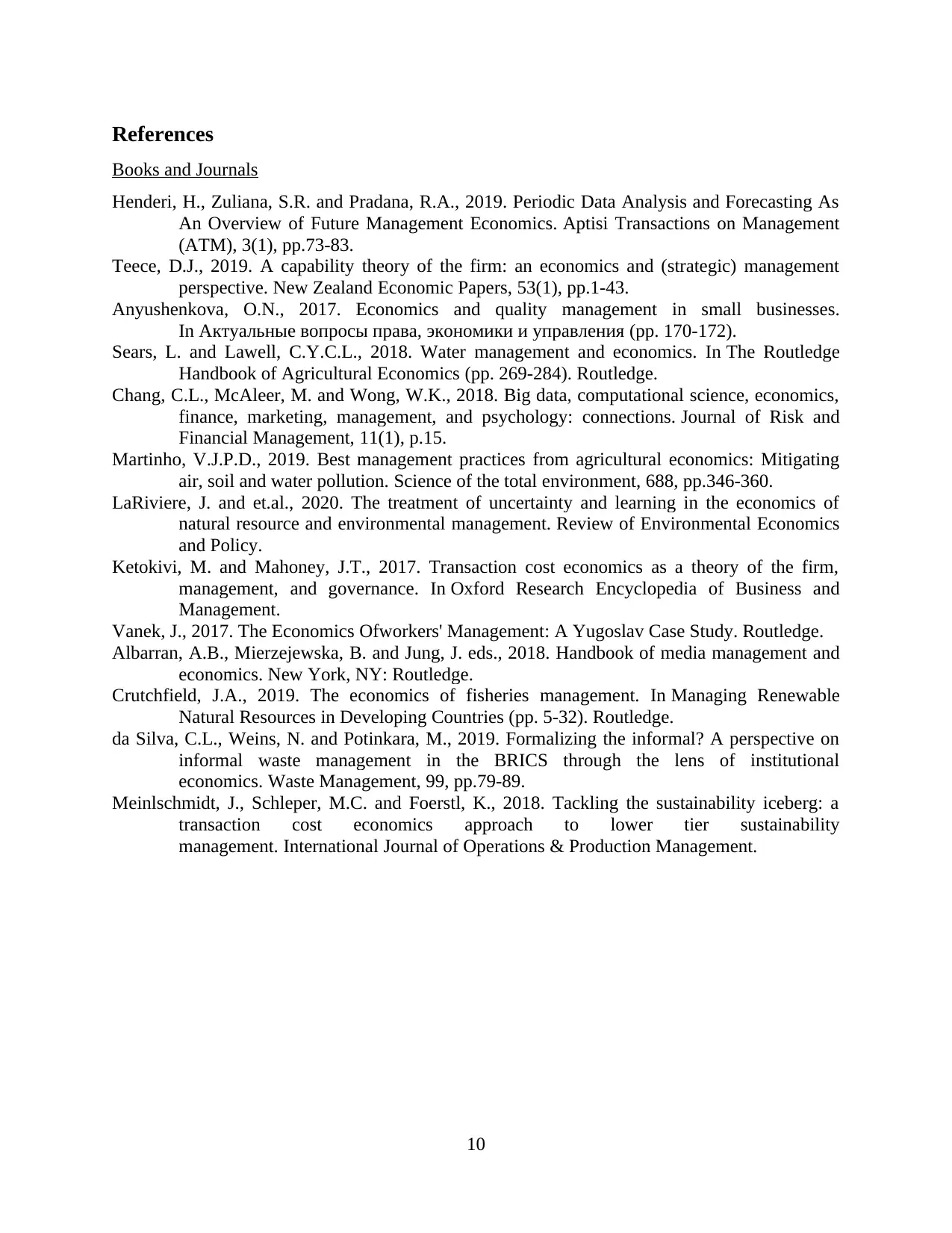
References
Books and Journals
Henderi, H., Zuliana, S.R. and Pradana, R.A., 2019. Periodic Data Analysis and Forecasting As
An Overview of Future Management Economics. Aptisi Transactions on Management
(ATM), 3(1), pp.73-83.
Teece, D.J., 2019. A capability theory of the firm: an economics and (strategic) management
perspective. New Zealand Economic Papers, 53(1), pp.1-43.
Anyushenkova, O.N., 2017. Economics and quality management in small businesses.
In Актуальные вопросы права, экономики и управления (pp. 170-172).
Sears, L. and Lawell, C.Y.C.L., 2018. Water management and economics. In The Routledge
Handbook of Agricultural Economics (pp. 269-284). Routledge.
Chang, C.L., McAleer, M. and Wong, W.K., 2018. Big data, computational science, economics,
finance, marketing, management, and psychology: connections. Journal of Risk and
Financial Management, 11(1), p.15.
Martinho, V.J.P.D., 2019. Best management practices from agricultural economics: Mitigating
air, soil and water pollution. Science of the total environment, 688, pp.346-360.
LaRiviere, J. and et.al., 2020. The treatment of uncertainty and learning in the economics of
natural resource and environmental management. Review of Environmental Economics
and Policy.
Ketokivi, M. and Mahoney, J.T., 2017. Transaction cost economics as a theory of the firm,
management, and governance. In Oxford Research Encyclopedia of Business and
Management.
Vanek, J., 2017. The Economics Ofworkers' Management: A Yugoslav Case Study. Routledge.
Albarran, A.B., Mierzejewska, B. and Jung, J. eds., 2018. Handbook of media management and
economics. New York, NY: Routledge.
Crutchfield, J.A., 2019. The economics of fisheries management. In Managing Renewable
Natural Resources in Developing Countries (pp. 5-32). Routledge.
da Silva, C.L., Weins, N. and Potinkara, M., 2019. Formalizing the informal? A perspective on
informal waste management in the BRICS through the lens of institutional
economics. Waste Management, 99, pp.79-89.
Meinlschmidt, J., Schleper, M.C. and Foerstl, K., 2018. Tackling the sustainability iceberg: a
transaction cost economics approach to lower tier sustainability
management. International Journal of Operations & Production Management.
10
Books and Journals
Henderi, H., Zuliana, S.R. and Pradana, R.A., 2019. Periodic Data Analysis and Forecasting As
An Overview of Future Management Economics. Aptisi Transactions on Management
(ATM), 3(1), pp.73-83.
Teece, D.J., 2019. A capability theory of the firm: an economics and (strategic) management
perspective. New Zealand Economic Papers, 53(1), pp.1-43.
Anyushenkova, O.N., 2017. Economics and quality management in small businesses.
In Актуальные вопросы права, экономики и управления (pp. 170-172).
Sears, L. and Lawell, C.Y.C.L., 2018. Water management and economics. In The Routledge
Handbook of Agricultural Economics (pp. 269-284). Routledge.
Chang, C.L., McAleer, M. and Wong, W.K., 2018. Big data, computational science, economics,
finance, marketing, management, and psychology: connections. Journal of Risk and
Financial Management, 11(1), p.15.
Martinho, V.J.P.D., 2019. Best management practices from agricultural economics: Mitigating
air, soil and water pollution. Science of the total environment, 688, pp.346-360.
LaRiviere, J. and et.al., 2020. The treatment of uncertainty and learning in the economics of
natural resource and environmental management. Review of Environmental Economics
and Policy.
Ketokivi, M. and Mahoney, J.T., 2017. Transaction cost economics as a theory of the firm,
management, and governance. In Oxford Research Encyclopedia of Business and
Management.
Vanek, J., 2017. The Economics Ofworkers' Management: A Yugoslav Case Study. Routledge.
Albarran, A.B., Mierzejewska, B. and Jung, J. eds., 2018. Handbook of media management and
economics. New York, NY: Routledge.
Crutchfield, J.A., 2019. The economics of fisheries management. In Managing Renewable
Natural Resources in Developing Countries (pp. 5-32). Routledge.
da Silva, C.L., Weins, N. and Potinkara, M., 2019. Formalizing the informal? A perspective on
informal waste management in the BRICS through the lens of institutional
economics. Waste Management, 99, pp.79-89.
Meinlschmidt, J., Schleper, M.C. and Foerstl, K., 2018. Tackling the sustainability iceberg: a
transaction cost economics approach to lower tier sustainability
management. International Journal of Operations & Production Management.
10
1 out of 10
Related Documents
Your All-in-One AI-Powered Toolkit for Academic Success.
+13062052269
info@desklib.com
Available 24*7 on WhatsApp / Email
![[object Object]](/_next/static/media/star-bottom.7253800d.svg)
Unlock your academic potential
Copyright © 2020–2025 A2Z Services. All Rights Reserved. Developed and managed by ZUCOL.





